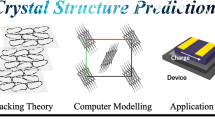Abstract
The habit (external morphology) of a crystal is controlled by both the external (environmental) conditions of crystallization and the internal (structural) factors of the crystal. In order to separate the effects of the crystal structure and of the solvent and other external factors on the experimentally observed growth habit, the theoretical habit can be derived from the crystal structure using the periodic bond chain (PBC) theory and attachment energy considerations. According to the PBC theory the crystal habit is governed by a set of uninterrupted chains of strong bonds formed in the crystal lattice. In addition, the attachment energy (E att) is defined as the energy released per mole when a new layer is deposited on a crystal face. Since the habit of a crystal is determined by the relative growth rate (R) of the various faces, by taking R proportional to E att, the theoretical habit can thus be derived from E att. Using this approach, we obtained the theoretical crystal habit of an antitumor drug, hexamethylmelamine (HMM). The possible effect of solvents on the habit modification of HMM is discussed. This technique, based purely on the knowledge of the crystal structure, is directly applicable to other pharmaceuticals in deriving their theoretical crystal habit.
Similar content being viewed by others
REFERENCES
A. H.-L. Chow, P. K. K. Chow, Z. Wang, and D. J. W. Grant. Modification of acetaminophen crystals: Influence of growth in aqueous solutions containing p-acetoxyacetanilide on crystal properties. Int. J. Pharm. 24:239–258 (1985).
N. Garti and F. Tibika. Habit modifications of nitrofurantoin crystallized from formic acid mixtures. Drug Dev. Ind. Pharm. 6:379–398 (1980).
N. Rodriguez-Hornedo and H.-J. Wu. Crystal growth kinetics of theophylline monohydrate. Pharm. Res. 8:643–648 (1991).
H.-K. Chan and I. Gonda. Respirable form of crystals of cromoglycic acid. J. Pharm. Sci. 78:176–180 (1989).
I. Gonda, A. F. A. E. Khalik, and A. Z. Britten. Hexamethyl-melamine aerosols prepared in an evaporation-condensation generator. Int. J. Pharm. 27:255–265 (1985).
I. Gonda and A. F. A. E. Khalik. Aerodynamic properties of different crystal forms of hexamethylmelamine. Ann. Occup. Hyg. 32:379–390 (1988).
H.-K. Chan and I. Gonda. Studies of the mechanism of crystal growth of hexamethylmelamine. II. Rates of growth of the crystal faces. J. Cryst. Growth 108:751–758 (1991).
H.-K. Chan, I. Gonda, and A. McLachlan. Studies of the mechanism of crystal growth of hexamethylmelamine. I. Solute-solvent interaction. J. Cryst. Growth 104:355–365 (1990).
H.-K. Chan and I. Gonda. Serendipitous preparation of crystals of methotrexate and attempts to modify its crystal habit. J. Cryst. Growth 94:488–498 (1989).
H.-K. Chan and I. Gonda. Methotrexate: Existence of different types of solid. Int. J. Pharm. 68:179–190 (1991).
J. K. Haleblian. Characterization of habits and crystalline modification of solid and their pharmaceutical applications. J. Pharm. Sci. 64:1269–1288 (1975).
H. M. Burt and A. G. Mitchell. Crystal defects and dissolution. Int. J. Pharm. 9:137–152 (1981).
H. M. Burt and A. G. Mitchell. Dissolution anisotropy in nickel sulfate α hexahydrate crystals. Int. J. Pharm. 3:261–274 (1979).
H.-K. Chan and D. J. W. Grant. Influence of compaction on the intrinsic dissolution rate of modified acetaminophen and adipic acid crystals. Int. J. Pharm. 57:117–124 (1989).
C. Rinaudo and R. Boistelle. The occurrence of uric acids and the growth morphology of the anhydrous monoclinic modification: C5H4N4O3. J. Cryst. Growth 49:569–579 (1980).
M. Saska and A. S. Myerson. The theoretical shape of sucrose crystals from energy considerations. J. Cryst. Growth 61:546–555 (1983).
D. Aquilano, M. Rubbo, G. Mantovani, G. Sgualdino, and G. Vaccari. Equilibrium and growth forms of sucrose crystals in the {hol} zone 1. theoretical treatment of {101}-d form. J. Cryst. Growth 74:10–20 (1986).
P. Hartman. The dependence of crystal morphology on crystal structure. In N. N. Sheftal (ed.), Growth of Crystals, Vol. 7, 1969, pp. 3–18.
J. W. Mullin. Crystallisation, 2nd ed., Butterworth, London, 1972, pp. 164, 170–173.
A. F. Wells. Crystal habit and internal strucutre—I. Phil. Mag. 37:184–199 (1946).
A. F. Wells. III. Abnormal and modified crystal growth. Disc. Farad. Soc. 5:197–201 (1949).
P. Hartman. Structure and morphology. In P. Hartman (ed.), Crystal Growth: An Introduction, North-Holland, Amsterdam, 1973, pp. 367–402.
P. Hartman. Modern PBC theory. In I. Sunagawa (ed.), Morphology of Crystals, Terra Scientific, Tokyo, 1987, pp. 269–319.
P. Hartman and P. Bennema. The attachment energy as a habit controlling factor I. Theoretical considerations. J. Cryst. Growth 49:145–156 (1980).
P. Hartman. Structural morphology of organic compounds having two centrosymmetric molecules in a monoclinic unit cell. J. Cryst. Growth 110:559–570 (1991).
G. J. Bullen, D. J. Corney, and F. S. Stephens. Crystal and molecular structure of hexamethylmelamine [2,4,6-tris(dimethylamino)-1,3,5-triazine]. J. C. S. Perkin II 1972:642–646 (1972).
G. Clyesdale, R. Docherty, and K. J. Roberts. HABIT—a program for predicting the morphology of molecular crystals. Comp. Phys. Comm. 64:311–328 (1991).
R. Docherty, G. Clydesdale, K. J. Roberts, and P. Bennema. Application of Bravais-Friedel-Donnay-Harker, attachment energy and Ising models to predicting and understanding the morphology of molecular crystals. J. Phys. D Appl. Phys. 24:89–99 (1991).
Author information
Authors and Affiliations
Rights and permissions
About this article
Cite this article
Hartman, P., Chan, HK. Application of the Periodic Bond Chain (PBC) Theory and Attachment Energy Consideration to Derive the Crystal Morphology of Hexamethylmelamine. Pharm Res 10, 1052–1058 (1993). https://doi.org/10.1023/A:1018927109487
Issue Date:
DOI: https://doi.org/10.1023/A:1018927109487




